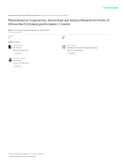| dc.contributor.author | Nassazi, Winfred | |
| dc.contributor.author | K’Owino, Isaac O. | |
| dc.contributor.author | Makatiani, Jacqueline | |
| dc.contributor.author | Wachira, Sabina | |
| dc.date.accessioned | 2023-12-13T14:59:14Z | |
| dc.date.available | 2023-12-13T14:59:14Z | |
| dc.date.issued | 2020-09-01 | |
| dc.identifier.uri | https://doi.org/10.9734/AJACR/2020/v6i430166 | |
| dc.identifier.uri | https://www.researchgate.net/profile/Winfred-Nassazi-2/publication/344015582_Phytochemical_Composition_Antioxidant_and_Antiproliferative_Activities_of_African_Basil_Ocimum_gratissimum_L_Leaves/links/5f4e179f458515a88ba7017c/Phytochemical-Composition-Antioxidant-and-Antiproliferative-Activities-of-African-Basil-Ocimum-gratissimum-L-Leaves.pdf | |
| dc.identifier.uri | http://ir-library.mmust.ac.ke:8080/xmlui/handle/123456789/2488 | |
| dc.description.abstract | Aim: To determine the phytochemicals in Ocimum gratissimum leaves, their phenolic content,
antioxidant potential and antiproliferative activity against human prostate (DU145), colon (CT26)
and cervical (HeLa 229) cancer cells.
Place and Duration of the Study: Leaves of O. gratissimum were collected from cultivated plants
in Wakiso district of Uganda. The samples were analyzed at Directorate of Government Analytical
Original Research Article
Nassazi et al.; AJACR, 6(4): 1-18, 2020; Article no.AJACR.60474
2
Laboratory, Kampala (Uganda) and Kenya Medical Research Institute, Centre for Traditional
Medicine and Drug Research, Nairobi (Kenya) between August 2019 and January 2020.
Methodology: The leaves were separately extracted by maceration using hexane,
dichloromethane, ethyl acetate and methanol. The methanolic extract was further fractionated and
subjected to solid phase extraction. Antiproliferative assay was done using dimethylthiazol-2,5-
diphenyl-tetrazolium bromide assay while total phenolic content and antioxidant activity were
determined by Folin-Ciocalteu method and 2,2-diphenyl-1-picrylhydrazyl radical scavenging assay
respectively. Compounds were identified by Fourier transform infrared spectroscopy and liquid
chromatography-tandem mass spectrometry.
Results: A total of 34 compounds were identified in the fractions. The highest mean total phenolic
content was 401.07 ± 6.47 µg/ml for the methanolic extract which also had the highest antioxidant
activity with minimum inhibitory concentration of 5.79 ± 0.13 mg/ml. There was a positive
correlation between the antioxidant activity of the extracts and antiproliferative activity of the
extracts on prostate and cervical cancer cell lines. The extracts exhibited the highest toxicity
against prostate cancer cells and the least against cervical cancer cells.
Conclusion: The results of this study support the traditional use of this plant in cancer therapy in
Uganda. Further research should isolate pure anticancer compounds from this plant which could
act as lead candidates in the development of anticancer drugs. | en_US |
| dc.language.iso | en | en_US |
| dc.publisher | Asian Journal of Applied Chemistry Research | en_US |
| dc.subject | Phytochemical, Composition, Antioxidant, Antiproliferative, Activities, African, Basil, (Ocimum gratissimum L.), Leaves | en_US |
| dc.title | Phytochemical Composition, Antioxidant and Antiproliferative Activities of African Basil (Ocimum gratissimum L.) Leaves | en_US |
| dc.type | Article | en_US |

